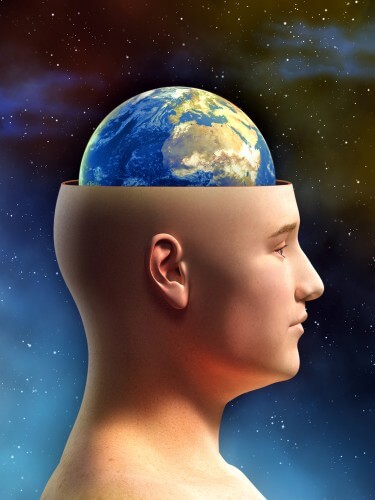Is it possible to predict what evolutionary changes will occur in humans in the very distant future? No, but interesting to try.
Malcolm Brown
Is it possible to predict what evolutionary changes will occur in humans in the very distant future? No, but interesting to try.
One thing is certain: one of the most important links in the evolutionary ladder was the transition from unicellular to multicellular creatures. Is it possible, similar to the process that the cells went through, that in millions of years the single person will become a multi-person - a kind of human super being, whose components have given up their individual impulses and developed a common identity?
This is of course pure speculation, but not unacceptable. This is according to a study by Danish scientists, recently published in the journal "Nature".
The researchers looked at the way yeast works, the kind that is used to leaven dough. Yeast cells normally lead their lives independently. Even when they cause a change in the dough, ferment grape juice or cause fungal infections, they do so in isolation from each other. The researchers from the University of Copenhagen, led by Dr. Sona Dano, succeeded in creating a yeast community in which all the cells secreted in increasing and decreasing doses and in a coordinated manner a chemical substance called NADH, which is created when an organism breaks down sugar to create energy.
This phenomenon, in which NADH concentrations rise and fall at a uniform rate, has been observed in the past. What Dr. Dano's team did was to find a way to make this concentration variation curve continue indefinitely. To do this, they used the theory that won the Belgian Ilya Prigogine the Nobel Prize in Chemistry in 1977. Dr. Prigogine showed that although according to the laws of thermodynamics most physical processes "degrade downhill" - that is, the level of disorder in them is increasing - it is possible To create a situation of "uphill climbing", in the direction of increasing complexity and order, in the so-called "open" systems. Open systems, to which Dr. Prigogin refers, are those to which energy is regularly added and waste is removed from them. Trees and humans are examples of such open systems.

In Dr. Dano's application of this idea, a glass tube containing yeast cells is taken, new yeast cells are continuously added to it, as well as glucose and cyanide, and waste and excess fluids are removed from it. When a balance is reached between the energy that is added and the waste that is removed, permanent chemical oscillations are obtained, similar to the ticking of a clock, which continue as long as the balance between the addition of energy and the removal of waste is maintained. Collective chemical fluctuations in yeast colonies, the Danish researchers wrote, "indicate the existence of an evolutionary path leading from unicellular behavior to multicellular behavior."
Yeast cells are not the only organisms that routinely cross the line between unicellular and multicellular existence. Unicellular bacteria can form giant mat-like colonies, living almost like multicellular creatures. Evidence that such carpets existed in Earth's early years has been found in ancient rocks.
Soil amoebae - highly complex unicellular organisms - live separately from each other when food is abundant, but in depleted environments they join each other to form spores, and in their collective state they can move relatively quickly, when sensations of light and heat guide them towards food supplies.
Among the oldest multicellular animals that have what appears to be a sense of self are the sponges, which can exist either as independent cells that move freely or as giant aggregates of cells held together by skeletons made of protein and minerals, and containing complex food-filtering pipelines. The sponges, previously thought to be immobile, crawl over a surface at a speed of several millimeters per day in search of food.
At higher levels of organization, many individual insects - ants and bees, for example - function as components of the "superbeing" represented by the nest or hive.
Even higher on the scale of complexity are birds that gather in flocks, fish that swim in a coordinated and perfect choreography, and the naked rat - a small and almost blind animal that lives in the deserts of East Africa. Every detail in the rat colony plays the role of a cog in a large cogwheel. Only one female in the colony gives birth; The other rats have specific roles: searching for food, caring for the cubs, guarding against predators and cleaning.
In 1932, in the book "Brave New World", Aldous Huxley envisioned a human society in which individuals are programmed before birth. Whether they belonged to the high level of existence, "intellectuals of the alpha-plus type", or to the low level, "retards of the epsilon-minus type", or to any of the intermediate levels, each person had a defined profession and purpose.
But the world that Huxley describes has enough resources to allow for a future where humans will continue to act individually. Even in our world today there are enough resources for this. But could a situation arise in which the essential means of existence will run out and we will be forced to develop in the direction of a "super creature"?
New York Times
{Appeared in Haaretz newspaper, 7/12/1999{
The knowledge site was at that time part of the IOL portal of the Haaretz group

3 תגובות
It's amazing that for so many years there is not a single comment. I'm proud to be the first.
I arrived from Kishore in an updated class on August 16.8.09, XNUMX
https://www.hayadan.org.il/human-evolution-continue-1608093/
By the way, the Twin Towers in New York fell on September 11.9.01, XNUMX
stop it